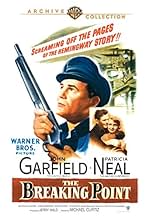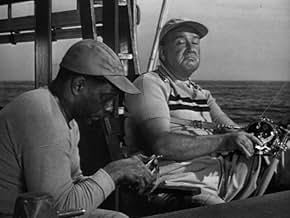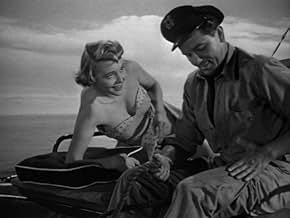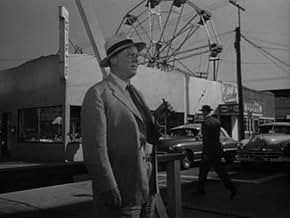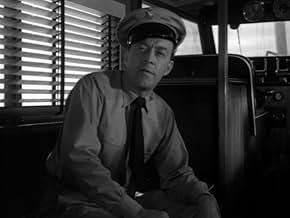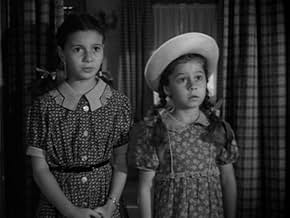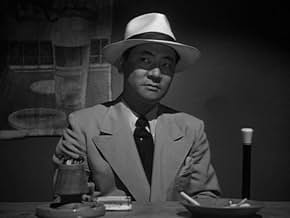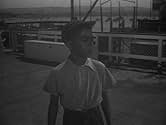NOTE IMDb
7,5/10
4,9 k
MA NOTE
Ajouter une intrigue dans votre langueAn otherwise moral captain of a charter boat becomes financially strapped and is drawn into illegal activities in order to keep up payments on his boat.An otherwise moral captain of a charter boat becomes financially strapped and is drawn into illegal activities in order to keep up payments on his boat.An otherwise moral captain of a charter boat becomes financially strapped and is drawn into illegal activities in order to keep up payments on his boat.
- Réalisation
- Scénario
- Casting principal
- Récompenses
- 4 victoires au total
John Alvin
- Reporter
- (non crédité)
Chet Brandenburg
- Taxi Driver
- (non crédité)
Peter Brocco
- Macho
- (non crédité)
Mary Carroll
- Girl at Bar
- (non crédité)
Spencer Chan
- 1st Chinese Immigrant
- (non crédité)
John Close
- Deputy
- (non crédité)
Avis à la une
"The Breaking Point" is technically considered to be a remake of Ernest Hemingway's "To Have and Have Not," first brought to the screen with Bogie and Bacall. But it feels like a whole different story in just about every conceivable way. John Garfield excelled at playing prototypical noir heroes, desperate men doing desperate things when feeling trapped by an unfair fate. This is the role he has here, and watching his character dig himself deeper and deeper into shady doings that he knows are shady from the outset is like watching a slowly unfolding car accident. Patricia Neal is extremely fetching and knows how to deliver a sardonic one liner like no one's business, but the script doesn't do a whole lot with her other than have her appear here and there as window dressing. The stand out for me was Phyllis Thaxter as Garfield's plain Jane wife. It's refreshing in a film from 1950 to see a housewife portrayed as something other than a mindless cipher for her husband's thoughts and desires. Instead, she has a mind of her own and reserves of strength he might not give her credit for.
The most quietly astonishing thing about "The Breaking Point" is its treatment of Garfield's friend and ship assistant, a black man played by Juano Hernandez. The fact that he's black is a complete non-issue in the film. He's treated as an equal by Garfield and his family, and none of the stereotypes about black people that were so prevalent in movies from this time period, even in movies with their hearts in the right places, are present here. The final scene of the film involves this character's son, and it's so striking, and so devastating, that in retrospect the entire film almost seems to be about that scene even though it has almost nothing to do with everything that's come before it.
Michael Curtiz provides the no-frills direction.
Grade: A
The most quietly astonishing thing about "The Breaking Point" is its treatment of Garfield's friend and ship assistant, a black man played by Juano Hernandez. The fact that he's black is a complete non-issue in the film. He's treated as an equal by Garfield and his family, and none of the stereotypes about black people that were so prevalent in movies from this time period, even in movies with their hearts in the right places, are present here. The final scene of the film involves this character's son, and it's so striking, and so devastating, that in retrospect the entire film almost seems to be about that scene even though it has almost nothing to do with everything that's come before it.
Michael Curtiz provides the no-frills direction.
Grade: A
An underrated flick in the Garfield canon. His charter boat captain, Morgan, may not be very likable, but the actor makes him a compelling tough guy. So, how's Morgan going to pay his debts and keep his charter boat. It's a struggle, especially when wheedling deal-maker Duncan (Ford) keeps tempting him with illegal transporting. It's really a battle for Morgan's soul though he doesn't realize it. On one hand there's faithful wife Lucy (Thaxter) and two small daughters, along with deck hand Park (Hernandez) depending on him for support. On the other, is smoothy Duncan, sultry temptress Leona (Neal), and an array of criminal types offering him money for illegal services. Trouble is Morgan loves both Lucy and his boat, so will he stay honest and get a new livelihood, or will he succumb to seductive overtures from Duncan and turn criminal boat captain.
Garfield's Morgan is not a nice guy, so the outcome is uncertain. Every other word is a smart-alecky remark, and though he loves wife Lucy and the two little girls, he seems to forget them when obsessing about his boat. Clearly, his ego is tied up with being a captain.
It's a perfect Garfield role, and he gives no quarter. At the same time, Thaxter works wonders as the sympathetic wife without getting smarmy, a really difficult role. And shouldn't overlook Neal whose grinning blonde temptress resembles a figure from perhaps the lower regions. Then too, inclusion of Black actor Hernandez was a bold one for 1950 when Black actors were still mostly servants or comic relief. Moreover, his inclusion results indirectly in one of the most brilliantly poignant final scenes in film annals. I get the feeling the writers were doing their best to avoid a typical Hollywood ending, which was still the norm.
All in all, the movie deserves a ranking just below Garfield's celebrated Force of Evil (1948) as a study in self-realization. Please, TCM, revive the flick whenever you can.
Garfield's Morgan is not a nice guy, so the outcome is uncertain. Every other word is a smart-alecky remark, and though he loves wife Lucy and the two little girls, he seems to forget them when obsessing about his boat. Clearly, his ego is tied up with being a captain.
It's a perfect Garfield role, and he gives no quarter. At the same time, Thaxter works wonders as the sympathetic wife without getting smarmy, a really difficult role. And shouldn't overlook Neal whose grinning blonde temptress resembles a figure from perhaps the lower regions. Then too, inclusion of Black actor Hernandez was a bold one for 1950 when Black actors were still mostly servants or comic relief. Moreover, his inclusion results indirectly in one of the most brilliantly poignant final scenes in film annals. I get the feeling the writers were doing their best to avoid a typical Hollywood ending, which was still the norm.
All in all, the movie deserves a ranking just below Garfield's celebrated Force of Evil (1948) as a study in self-realization. Please, TCM, revive the flick whenever you can.
The Breaking Point cannot properly be called a remake of To Have And Have Not as that classic film was altered to make the story relevant for domestic consumption in wartime America. There was also added the legendary chemistry of Bogey and Bacall in their first film together. Ernest Hemingway did not write that for the movie-going public.
The Breaking Point is far more Hemingway and far more realistically done. John Garfield makes a perfect Hemingway hero and the locations along the California coast aren't glamorized in any way. This is a working class locale and the black and white cinematography and wind swept look given by same reflects Garfield and the area he is raising his family in.
Garfield plays a World War II veteran who wanted to earn a living on the sea and have Phyllis Thaxter raise their daughters in that coastal location. But business comes in cycles and a bad season finds Garfield owing everyone including the butcher, the baker and candlestick maker. Most of all he owes for fuel and that guy is ready to take the boat for payment.
When a charter client stiffs him on the bill, Garfield is forced to make some bad choices to pay his bills and support his family. Providing some of those bad choices is Wallace Ford playing a truly sleazebag shyster living on the Mexican side of the Pacific coast who ostensibly will get you a quickie Mexican divorce, but dabbles in all kinds of illegal fields. Actually I'm being unfair, shysters make bad lawyer jokes about Ford.
Providing a little temptation for Garfield is Patricia Neal who is trying very hard for the same Lauren Bacall effect. She's the girlfriend of the client who stiffed Garfield in the first place and she has most original and cynical point of view about life and men.
The Breaking Point provides John Garfield with one of his best performances in his next to last film. And he far more fits the Hemingway conception as does the overall film itself.
The Breaking Point is far more Hemingway and far more realistically done. John Garfield makes a perfect Hemingway hero and the locations along the California coast aren't glamorized in any way. This is a working class locale and the black and white cinematography and wind swept look given by same reflects Garfield and the area he is raising his family in.
Garfield plays a World War II veteran who wanted to earn a living on the sea and have Phyllis Thaxter raise their daughters in that coastal location. But business comes in cycles and a bad season finds Garfield owing everyone including the butcher, the baker and candlestick maker. Most of all he owes for fuel and that guy is ready to take the boat for payment.
When a charter client stiffs him on the bill, Garfield is forced to make some bad choices to pay his bills and support his family. Providing some of those bad choices is Wallace Ford playing a truly sleazebag shyster living on the Mexican side of the Pacific coast who ostensibly will get you a quickie Mexican divorce, but dabbles in all kinds of illegal fields. Actually I'm being unfair, shysters make bad lawyer jokes about Ford.
Providing a little temptation for Garfield is Patricia Neal who is trying very hard for the same Lauren Bacall effect. She's the girlfriend of the client who stiffed Garfield in the first place and she has most original and cynical point of view about life and men.
The Breaking Point provides John Garfield with one of his best performances in his next to last film. And he far more fits the Hemingway conception as does the overall film itself.
I just saw this movie in the last week at a recent Film Noir Festival here in San Francisco. Garfield owns this role as a down on his luck captain of his boat. He is willing to take shady deals to make money for him and keep his family (his two young daughters) with money. His wife played by Phyllis Thaxter gives a fine turn as a wife and mother. Patricia Neal is smooth and dangerous in her role as a two timing blonde broad. The daughters that played the kids were effective and smart like their ages were depicted. Garfield's mate Wesley Park was very good in his role of Garfiled's suffering partner. The reptilian role of the attorney was convincing and nasty. The final minutes of the movie had me choked up with the performances from Garfield and Thaxter. Another great movie by Michael Curtiz. Why isn't this movie on DVD?
No one played the haunted/hunted character better than John Garfield (Humphrey Bogart is a close second). Here, Garfield is a boat captain that gets in way over his head. The thing with Garfield's characters, is that even though the audience sympathizes with his plight, the character always brings it on himself. With Garfield's usual acerbic delivery, his Harry Morgan is hard to like but when he is with his family, one sees that he is basically a headstrong but good guy. Even though Michael Curtiz directed this, the tone and especially the ending shot kept reminding me of Fritz Lang. I think this film should be commended for the ending, which although a somewhat happy one, reminds the audience of the affect of one's actions on everyone. This generally was ignored in a lot of the crime dramas from the 30's to the 60's. My only complaint is the Patricia Neal character seemed tacked on for romance sake. She didn't add much and certainly didn't have an impact on the main thrust of the story. But that is a minor quibble. Another gem for one of the move overlooked actors - John Garfield.
Le saviez-vous
- AnecdotesAccording to TCM's Eddie Muller, John Garfield thought this was his best performance and that it was the film of which he was most proud.
- GaffesWhen she first steps onto the boat, Patricia Neal's voice is heard saying "we're off to sunny Mexico," but her lips aren't moving.
- Citations
Harry Morgan: You know, my wife dyed her hair.
Leona Charles: Coincidentally I've been thinking of letting mine grow out. Speaking of coincidences, I live in Number Seven. My friends just kick the door open.
- Crédits fousTHE END close out. All lettering aligned and centered except for the line beneath Warner Bros. that begins PICTURES. It's left registered with whatever wording that followed it 'air brushed' over using the lower right drop shadow pattern leaving a Warner Bros. Pictures _?_?_?_?_ mystery.
- ConnexionsFeatured in The John Garfield Story (2003)
- Bandes originalesPlease Don't Talk About Me When I'm Gone
(uncredited)
Music by Sam H. Stept
Lyrics by Sidney Clare
Sung by Patricia Neal in the bar
Meilleurs choix
Connectez-vous pour évaluer et suivre la liste de favoris afin de recevoir des recommandations personnalisées
- How long is The Breaking Point?Alimenté par Alexa
Détails
- Durée1 heure 37 minutes
- Couleur
- Rapport de forme
- 1.33 : 1
Contribuer à cette page
Suggérer une modification ou ajouter du contenu manquant

Lacune principale
By what name was Trafic en haute mer (1950) officially released in India in English?
Répondre


